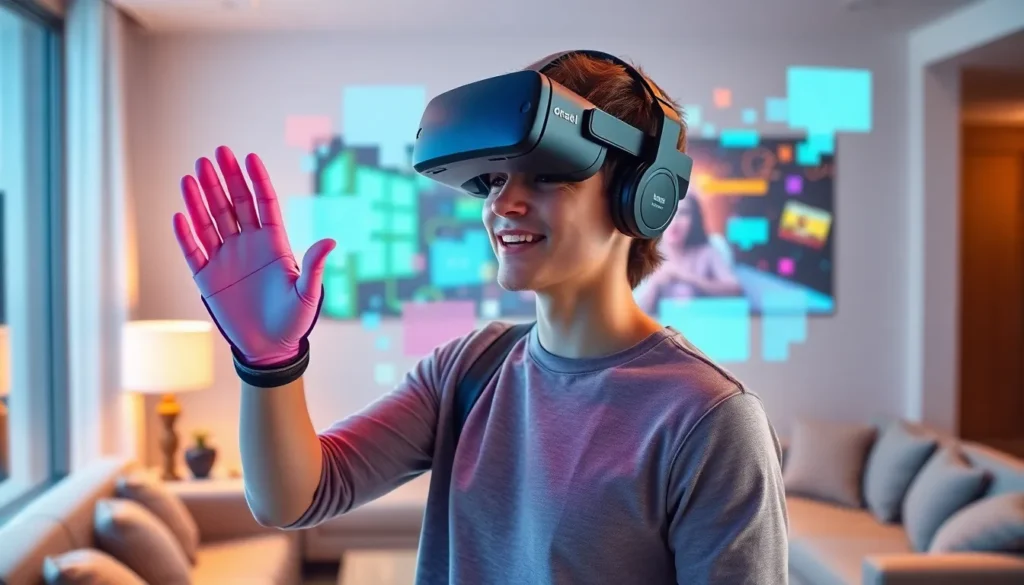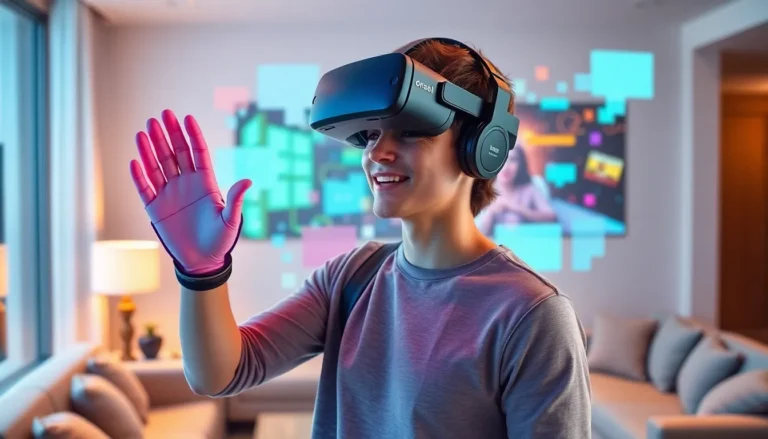Table of Contents
ToggleIn a world where flying robots and virtual landscapes are no longer just the stuff of sci-fi movies, drone and VR technology are taking center stage. Imagine soaring through the skies with a drone while simultaneously exploring a fantastical realm in virtual reality. It’s like being a superhero and a video game character rolled into one—minus the spandex suit.
Overview of Drone and VR Technology
Drones represent a significant leap in aerial technology. They provide a variety of applications, including aerial photography and delivery services. Users can navigate these unmanned aerial vehicles with precision, thanks to advancements in control systems. Features such as GPS and obstacle avoidance make flying safer and more accessible.
Virtual reality technology creates immersive environments for users. Headsets transport individuals to lifelike simulations, enhancing experiences in gaming and training scenarios. The combination of VR and drone technology allows users to pilot drones through virtual landscapes. This blend offers unique opportunities for exploration and entertainment.
Educational applications are expanding within both fields. Schools and universities integrate drones into curricula to teach students about robotics and aviation. VR enhances learning by allowing students to experience scenarios they can’t in real life. With these technologies, understanding complex subjects becomes more engaging.
In terms of industry, drone and VR technology drive innovation. Aerial mapping, surveying, and environmental monitoring benefit from drone capabilities. The construction and real estate sectors utilize drones for site assessments and architectural visualization. Simultaneously, VR supports businesses in marketing and training by providing realistic simulations of environments and products.
Market trends indicate rapid growth in both sectors. Reports estimate that the global drone market will exceed $43 billion by 2024. Meanwhile, the VR market is projected to reach $57 billion by 2027. As these technologies continue to evolve, they impact a wide range of industries, pushing the boundaries of what’s possible.
Impact of Drone and VR Technology
Drone and VR technology significantly alter various sectors and user experiences. Their integration into numerous industries showcases transformative impacts.
Applications in Various Industries
Drones now play a crucial role in agriculture, delivering precise crop data and facilitating efficient monitoring. Construction firms utilize drones for site assessments, enhancing safety and improving project management. In surveying, both drones and VR streamline data collection, making processes faster and more accurate. Environmental monitoring benefits from drone technology by enabling real-time observation of ecosystems. The film industry increasingly adopts drones for stunning aerial cinematography, creating immersive storytelling opportunities. A research study shows the drone market is projected to exceed $43 billion by 2024, indicating an anticipated growth in many applications.
Enhancing User Experience
VR technology revolutionizes user experiences by providing immersive environments for gaming and training. People can engage in realistic simulations, enhancing skills in various fields. Drones complement VR by allowing users to pilot them through virtual landscapes, creating interactive adventures. Enhanced user experience leads to increased engagement and enjoyment across applications. Educational platforms utilize these technologies to foster learning, producing captivating content for students. Streaming services explore integrating VR and drone technology for unique viewer engagement. The VR market is estimated to reach $57 billion by 2027, reflecting its growing impact on user experiences.
Future Trends in Drone and VR Technology
Drones and virtual reality continue to evolve, introducing exciting possibilities for the future. Innovations on the horizon promise to enhance user experiences and expand applications across various industries.
Innovations on the Horizon
Emerging technologies focus on integrating artificial intelligence with drones, enabling autonomous flight and advanced decision-making capabilities. Enhanced sensors improve data collection, increasing accuracy for applications like surveying and agriculture. Collaborations between drone manufacturers and VR developers facilitate more immersive experiences, allowing users to engage with environments in new ways. Cloud-based systems streamline data sharing and processing, enabling real-time collaboration in sectors like construction and disaster management. Additionally, advancements in battery technology promise longer flight times and increased operational efficiency, propelling drones into more extensive applications.
Challenges to Overcome
Despite growth, challenges persist in the drone and VR sectors. Regulatory hurdles often impede the widespread adoption of drones, with airspace management and privacy concerns requiring careful navigation. Ensuring data security remains critical, as sensitive information risks exposure during transmission. Technological limitations may restrict VR immersion, keeping users tethered to physical spaces when using certain systems. Additionally, improving accessibility to both technologies is vital, as costs can be prohibitive for some users. Addressing safety concerns regarding drone operations also demands ongoing attention, ensuring that innovations enhance user confidence while operating in various environments.
The convergence of drone and VR technology is reshaping industries and enhancing user experiences in unprecedented ways. As these technologies evolve they promise to unlock new possibilities in fields like education entertainment and environmental monitoring. With projected market growth and advancements in artificial intelligence the future looks bright for both drones and VR.
While challenges remain addressing regulatory and technological hurdles will be essential for maximizing their potential. As innovation continues to flourish these tools will not only redefine how we interact with the world but also elevate our capabilities to explore learn and create. The journey ahead is filled with exciting opportunities that will push the boundaries of imagination and functionality.







